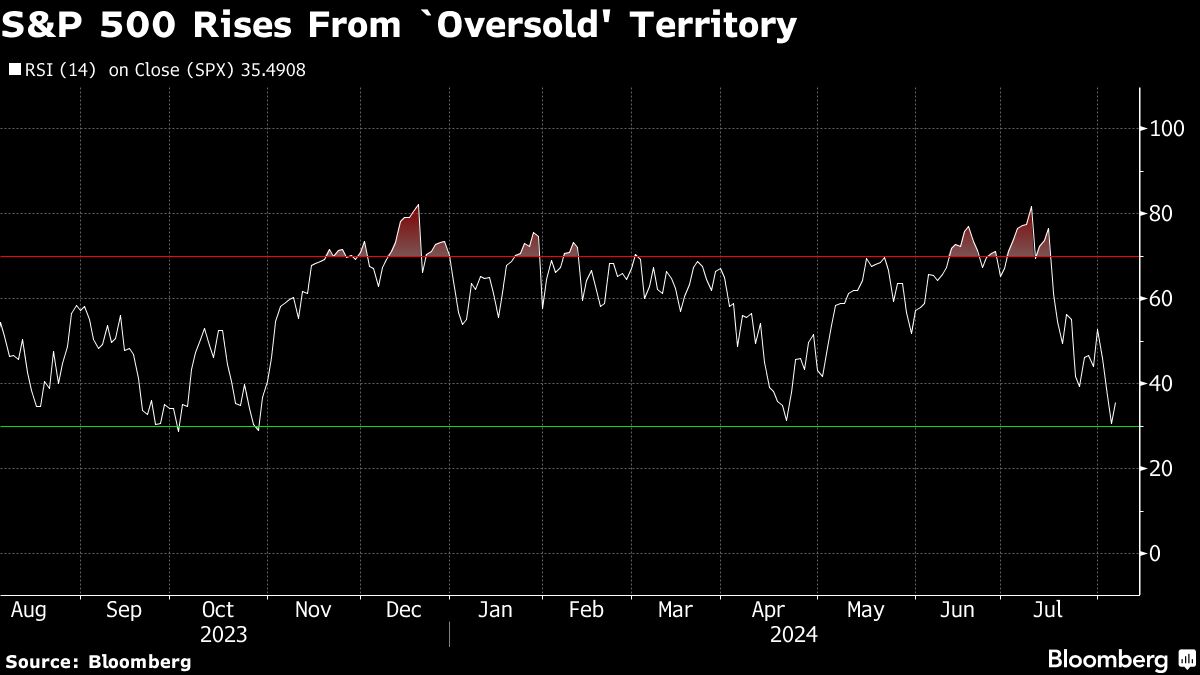
(Bloomberg) — Asian stocks resumed gains after an early bout of selling, in a sign that investors are still assessing the market’s outlook after the recent wild swings in global assets.
Most Read from Bloomberg
Japanese shares pared losses at the open, led by a rebound in financial firms. South Korea’s benchmark also rose, after a report that a version of Samsung Electronics’ HBM3E chip passed Nvidia’s tests. Futures pointed to modest gains in Hong Kong.
The S&P 500 and Nasdaq 100 rose on Tuesday — following a Japan-led rebound in Asia — with both climbing 1% after a global meltdown. Wall Street’s “fear gauge” — the VIX — saw its biggest plunge since 2010.
The dollar and Treasuries were steady in early Asia trading. The yen slipped for a second day after a recent surge.
“The critical element for Japanese, and as we’ve seen, global equities, is the strength of the yen, which is itself an expression of the US economic outlook,” said Kyle Rodda, a senior market analyst at Capital.Com. “For now, the USDJPY is waffling around 145. If it remains fairly non-volatile and perhaps grinds higher, it will support a Nikkei recovery and a return to normalcy.”
The government and the Bank of Japan agreed to closely monitor developments in the economy and financial markets with a sense of urgency, Vice Finance Minister for International Affairs Atsushi Mimura said after a meeting between the Finance Ministry, the BOJ and the Financial Services Agency.
Treasury 10-year yields were flat after jumping 10 basis points to 3.89% Tuesday. Traders are also moderating expectations of deep Federal Reserve rate cuts this year. Swaps point to around 105 basis points of easing, compared to as much as 150 basis points on Monday.
Elsewhere, the New Zealand dollar strengthened after the jobless rate rose less than expected. Oil fell after an industry report indicated a buildup in US inventories after five weeks of declines.
“We would characterize the recent market pullback as a textbook correction, after months of low volatility so far in 2024,” said Carol Schleif at BMO Family Office. “The lack of volatility before the past few weeks is unusual, and our current correction is actually quite normal, especially during August, which historically is a volatile time for markets given lighter trading volumes and the summer doldrums.”
The S&P 500 rose to 5,240. Nvidia Corp. jumped 3.8% to lead gains in chipmakers. Both the “Magnificent Seven” gauge of megacaps and the Russell 2000 of small firms added 1.2%.
A semblance of calm returned to markets on Tuesday, following a pullback fueled by weak economic data, underwhelming tech results, stretched positioning and poor seasonal trends. The wall of worry the market built up over the past few days drove the S&P 500 to the brink of a correction, with a drawdown of about 8.5% from the highs.
While such sharp declines in equity prices are concerning, historic data show “dips, pullbacks and corrections of 10% or more” are a normal and healthy part of any bull market, according to George Smith at LPL Financial.
Roughly 94% of the years since 1928 have experienced a pullback of at least 5%, and 64% of years have had at least one 10% correction, he noted.
“We believe that how common these occurrences are should provide comfort to equity investors, allowing them to be patient, stay invested, and most importantly, to not panic,” Smith said.
Key events this week:
-
China trade, forex reserves, Wednesday
-
US consumer credit, Wednesday
-
Germany industrial production, Thursday
-
US initial jobless claims, Thursday
-
Fed’s Thomas Barkin speaks, Thursday
-
China PPI, CPI, Friday
Some of the main moves in markets:
Stocks
-
S&P 500 futures were little changed as of 9:44 a.m. Tokyo time
-
Hang Seng futures rose 0.5%
-
Nikkei 225 futures (OSE) rose 0.3%
-
Japan’s Topix rose 0.5%
-
Australia’s S&P/ASX 200 fell 0.2%
-
Euro Stoxx 50 futures rose 0.5%
-
Nasdaq 100 futures were little changed
Currencies
-
The Bloomberg Dollar Spot Index was little changed
-
The euro was little changed at $1.0926
-
The Japanese yen fell 0.5% to 145.11 per dollar
-
The offshore yuan was little changed at 7.1627 per dollar
-
The Australian dollar rose 0.2% to $0.6532
Cryptocurrencies
-
Bitcoin fell 0.8% to $56,114.51
-
Ether fell 1.5% to $2,452.71
Bonds
-
The yield on 10-year Treasuries advanced one basis point to 3.90%
-
Japan’s 10-year yield was unchanged at 0.890%
-
Australia’s 10-year yield advanced six basis points to 4.08%
Commodities
-
West Texas Intermediate crude fell 0.3% to $73.01 a barrel
-
Spot gold fell 0.4% to $2,382.63 an ounce
This story was produced with the assistance of Bloomberg Automation.
Most Read from Bloomberg Businessweek
©2024 Bloomberg L.P.
EMEA Tribune is not involved in this news article, it is taken from our partners and or from the News Agencies. Copyright and Credit go to the News Agencies, email news@emeatribune.com Follow our WhatsApp verified Channel





